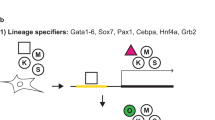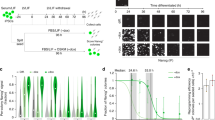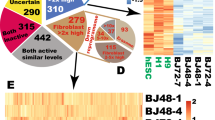Abstract
Present practices for reprogramming somatic cells to induced pluripotent stem cells involve simultaneous introduction of reprogramming factors. Here we report that a sequential introduction protocol (Oct4–Klf4 first, then c-Myc and finally Sox2) outperforms the simultaneous one. Surprisingly, the sequential protocol activates an early epithelial-to-mesenchymal transition (EMT) as indicated by the upregulation of Slug and N-cadherin followed by a delayed mesenchymal-to-epithelial transition (MET). An early EMT induced by 1.5-day TGF-β treatment enhances reprogramming with the simultaneous protocol, whereas 12-day treatment blocks reprogramming. Consistent results were obtained when the TGF-β antagonist Repsox was applied in the sequential protocol. These results reveal a time-sensitive role of individual factors for optimal reprogramming and a sequential EMT–MET mechanism at the start of reprogramming. Our studies provide a rationale for further optimizing reprogramming, and introduce the concept of a sequential EMT–MET mechanism for cell fate decision that should be investigated further in other systems, both in vitro and in vivo.
This is a preview of subscription content, access via your institution
Access options
Subscribe to this journal
Receive 12 print issues and online access
$209.00 per year
only $17.42 per issue
Buy this article
- Purchase on Springer Link
- Instant access to full article PDF
Prices may be subject to local taxes which are calculated during checkout








Similar content being viewed by others
Accession codes
References
Takahashi, K. & Yamanaka, S. Induction of pluripotent stem cells from mouse embryonic and adult fibroblast cultures by defined factors. Cell 126, 663–676 (2006).
Yu, J. et al. Induced pluripotent stem cell lines derived from human somatic cells. Science 318, 1917–1920 (2007).
Zhao, C., Deng, W. & Gage, F. H. Mechanisms and functional implications of adult neurogenesis. Cell 132, 645–660 (2008).
Kim, D. et al. Generation of human induced pluripotent stem cells by direct delivery of reprogramming proteins. Cell Stem. Cell 4, 472–476 (2009).
Okita, K., Nakagawa, M., Hyenjong, H., Ichisaka, T. & Yamanaka, S. Generation of mouse induced pluripotent stem cells without viral vectors. Science 322, 949–953 (2008).
Warren, L. et al. Highly efficient reprogramming to pluripotency and directed differentiation of human cells with synthetic modified mRNA. Cell Stem. Cell 7, 618–630 (2010).
Zhou, H. et al. Generation of induced pluripotent stem cells using recombinant proteins. Cell Stem. Cell 4, 381–384 (2009).
Liao, J. et al. Generation of induced pluripotent stem cell lines from adult rat cells. Cell Stem. Cell 4, 11–15 (2009).
Liu, H. et al. Generation of induced pluripotent stem cells from adult rhesus monkey fibroblasts. Cell Stem. Cell 3, 587–590 (2008).
Nelson, T. J., Martinez-Fernandez, A. & Terzic, A. Induced pluripotent stem cells: developmental biology to regenerative medicine. Nat. Rev. Cardiol. 7, 700–710 (2010).
Cheng, L. et al. Low incidence of DNA sequence variation in human induced pluripotent stem cells generated by nonintegrating plasmid expression. Cell Stem. Cell 10, 337–344 (2012).
Hussein, S. M. et al. Copy number variation and selection during reprogramming to pluripotency. Nature 471, 58–62 (2011).
Fairchild, P. J. The challenge of immunogenicity in the quest for induced pluripotency. Nat. Rev. Immunol. 10, 868–875 (2010).
Zhao, T., Zhang, Z. N., Rong, Z. & Xu, Y. Immunogenicity of induced pluripotent stem cells. Nature 474, 212–215 (2011).
Young, M. A. et al. Background mutations in parental cells account for most of the genetic heterogeneity of induced pluripotent stem cells. Cell Stem. Cell 10, 570–582 (2012).
Esteban, M. A. et al. Vitamin C enhances the generation of mouse and human induced pluripotent stem cells. Cell Stem. Cell 6, 71–79 (2010).
Wang, T. et al. The histone demethylases Jhdm1a/1b enhance somatic cell reprogramming in a vitamin-C-dependent manner. Cell Stem. Cell 9, 575–587 (2011).
Chen, J. et al. H3K9 methylation is a barrier during somatic cell reprogramming into iPSCs. Nat. Genet. 45, 34–42 (2012).
Esteban, M. A. & Pei, D. Vitamin C improves the quality of somatic cell reprogramming. Nat. Genet. 44, 366–367 (2012).
Li, R. et al. A mesenchymal-to-epithelial transition initiates and is required for the nuclear reprogramming of mouse fibroblasts. Cell Stem Cell 7, 51–63 (2010).
Hanna, J. et al. Direct cell reprogramming is a stochastic process amenable to acceleration. Nature 462, 595–601 (2009).
Buganim, Y. et al. Single-cell expression analyses during cellular reprogramming reveal an early stochastic and a late hierarchic phase. Cell 150, 1209–1222 (2012).
Carey, B. W. et al. Reprogramming of murine and human somatic cells using a single polycistronic vector. Proc. Natl Acad. Sci. USA 106, 157–162 (2009).
Pan, G., Li, J., Zhou, Y., Zheng, H. & Pei, D. A negative feedback loop of transcription factors that controls stem cell pluripotency and self-renewal. FASEB J. 20, 1730–1732 (2006).
Ruiz, S. et al. A high proliferation rate is required for cell reprogramming and maintenance of human embryonic stem cell identity. Curr. Biol. 21, 45–52 (2010).
Samavarchi-Tehrani, P. et al. Functional genomics reveals a BMP-driven mesenchymal-to-epithelial transition in the initiation of somatic cell reprogramming. Cell Stem. Cell 7, 64–77 (2010).
Conacci-Sorrell, M. et al. Autoregulation of E-cadherin expression by cadherin–cadherin interactions: the roles of β-catenin signaling, Slug, and MAPK. J. Cell Biol. 163, 847–857 (2003).
Maeda, M., Johnson, K. R. & Wheelock, M. J. Cadherin switching: essential for behavioral but not morphological changes during an epithelium-to-mesenchyme transition. J. Cell Sci. 118, 873–887 (2005).
Shih, J. Y. & Yang, P. C. The EMT regulator slug and lung carcinogenesis. Carcinogenesis 32, 1299–1304 (2011).
Alves, C. C., Carneiro, F., Hoefler, H. & Becker, K.F. Role of the epithelial-mesenchymal transition regulator Slug in primary human cancers. Front Biosci. 14, 3035–3050 (2009).
Schulte, J. et al. Expression of the E-cadherin repressors Snail, Slug and Zeb1 in urothelial carcinoma of the urinary bladder: relation to stromal fibroblast activation and invasive behaviour of carcinoma cells. Histochem. Cell Biol. 138, 847–860 (2012).
Wels, C., Joshi, S., Koefinger, P., Bergler, H. & Schaider, H. Transcriptional activation of ZEB1 by Slug leads to cooperative regulation of the epithelial-mesenchymal transition-like phenotype in melanoma. J. Invest. Dermatol. 131, 1877–1885 (2011).
Chiou, S. H. et al. Coexpression of Oct4 and Nanog enhances malignancy in lung adenocarcinoma by inducing cancer stem cell-like properties and epithelial-mesenchymal transdifferentiation. Cancer Res. 70, 10433–10444 (2010).
Liu, Y. N. et al. Critical and reciprocal regulation of KLF4 and SLUG in transforming growth factor β-initiated prostate cancer epithelial-mesenchymal transition. Mol. Cell. Biol. 32, 941–953 (2012).
Ichida, J. K. et al. A small-molecule inhibitor of tgf- β signaling replaces sox2 in reprogramming by inducing nanog. Cell Stem. Cell 5, 491–503 (2009).
Soufi, A., Donahue, G. & Zaret, K. S. Facilitators and impediments of the pluripotency reprogramming factors’ initial engagement with the genome. Cell 151, 994–1004 (2012).
Friedl, P. & Alexander, S. Cancer invasion and the microenvironment: plasticity and reciprocity. Cell 147, 992–1009 (2011).
Thiery, J. P. Epithelial-mesenchymal transitions in tumour progression. Nat. Rev. Cancer 2, 442–454 (2002).
Palma-Nicolas, J. P. & Lopez-Colome, A. M. Thrombin induces slug-mediated E-cadherin transcriptional repression and the parallel Up-regulation of N-cadherin by a transcription-independent mechanism in RPE cells. J. Cell. Physiol. 228, 581–589 (2013).
Gravdal, K., Halvorsen, O. J., Haukaas, S. A. & Akslen, L. A. A switch from E-cadherin to N-cadherin expression indicates epithelial to mesenchymal transition and is of strong and independent importance for the progress of prostate cancer. Clin. Cancer Res. 13, 7003–7011 (2007).
Baum, B., Settleman, J. & Quinlan, M. P. Transitions between epithelial and mesenchymal states in development and disease. Sem. Cell Dev. Biol. 19, 294–308 (2008).
Lim, J. & Thiery, J. P. Epithelial-mesenchymal transitions: insights from development. Development 139, 3471–3486 (2012).
Davies, J. A. Mesenchyme to epithelium transition during development of the mammalian kidney tubule. Acta Anatom. 156, 187–201 (1996).
Nakaya, Y., Kuroda, S., Katagiri, Y. T., Kaibuchi, K. & Takahashi, Y. Mesenchymal-epithelial transition during somitic segmentation is regulated by differential roles of Cdc42 and Rac1. Dev. Cell 7, 425–438 (2004).
Nakajima, Y., Yamagishi, T., Hokari, S. & Nakamura, H. Mechanisms involved in valvuloseptal endocardial cushion formation in early cardiogenesis: roles of transforming growth factor (TGF)- β and bone morphogenetic protein (BMP). Anatom. Rec. 258, 119–127 (2000).
Li, B., Zheng, Y. W., Sano, Y. & Taniguchi, H. Evidence for mesenchymal-epithelial transition associated with mouse hepatic stem cell differentiation. PloS One 6, e17092 (2011).
Trusolino, L., Bertotti, A. & Comoglio, P. M. MET signalling: principles and functions in development, organ regeneration and cancer. Nat. Rev. Mol. Cell Biol. 11, 834–848 (2010).
Silva, J. et al. Promotion of reprogramming to ground state pluripotency by signal inhibition. PLoS Biol. 6, e253 (2008).
Qin, D. et al. Mouse meningiocytes express Sox2 and yield high efficiency of chimeras after nuclear reprogramming with exogenous factors. J. Biol. Chem. 283, 33730–33735 (2008).
Chen, J. et al. Rational optimization of reprogramming culture conditions for the generation of induced pluripotent stem cells with ultra-high efficiency and fast kinetics. Cell Res. 21, 884–894 (2011).
Acknowledgements
This work has been supported in part by the Strategic Priority Research Program of the Chinese Academy of Sciences (XDA01020302, XDA01020401), the Guangzhou International Science and Technology Cooperation Projects from the Bureau of Science and Information Technology of the Guangzhou Municipal Government (2012J5100007), the Guangdong Natural Science Foundation (S2012010010087), the National Natural Science Foundation of China (31100773, 30900854) and the Major New Drugs Innovation of Major National Scientific and Technological Project (2011ZX09102-010-01).
Author information
Authors and Affiliations
Contributions
H.Z. and D.P. conceived and supervised the study and wrote the manuscript. H.Z. and X.L. designed the experiments and analysed the data. All authors except H.Z. and D.P. performed the experiments.
Corresponding authors
Ethics declarations
Competing interests
The authors declare no competing financial interests.
Supplementary information
Supplementary Information
Supplementary Information (PDF 2673 kb)
Supplementary Table 1
Supplementary Information (XLSX 12 kb)
Supplementary Table 2
Supplementary Information (XLSX 11 kb)
Supplementary Table 3
Supplementary Information (XLSX 9 kb)
Supplementary Table 4
Supplementary Information (XLSX 13 kb)
Supplementary Table 5
Supplementary Information (XLSX 10 kb)
Rights and permissions
About this article
Cite this article
Liu, X., Sun, H., Qi, J. et al. Sequential introduction of reprogramming factors reveals a time-sensitive requirement for individual factors and a sequential EMT–MET mechanism for optimal reprogramming. Nat Cell Biol 15, 829–838 (2013). https://doi.org/10.1038/ncb2765
Received:
Accepted:
Published:
Issue Date:
DOI: https://doi.org/10.1038/ncb2765
This article is cited by
-
ID2 promotes tumor progression and metastasis in thyroid cancer
Endocrine (2024)
-
Unraveling the 2,3-diketo-l-gulonic acid-dependent and -independent impacts of l-ascorbic acid on somatic cell reprogramming
Cell & Bioscience (2023)
-
H3K36 methylation is a reprogramming barrier
Nature Cell Biology (2023)
-
Mechanisms, pathways and strategies for rejuvenation through epigenetic reprogramming
Nature Aging (2023)
-
AP-1 activity is a major barrier of human somatic cell reprogramming
Cellular and Molecular Life Sciences (2021)



